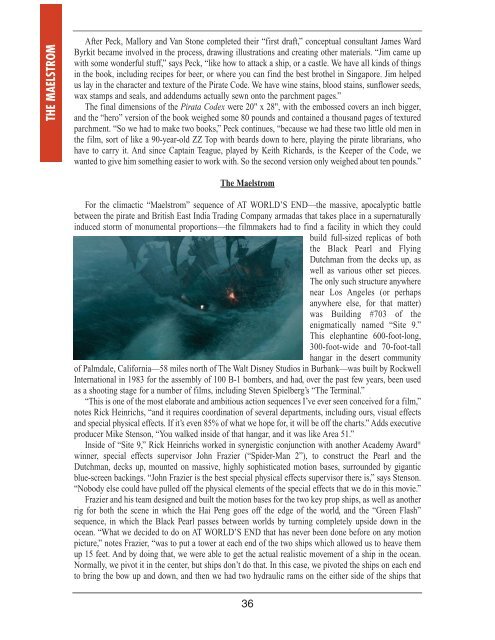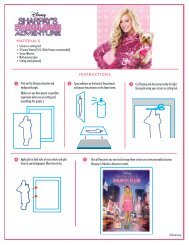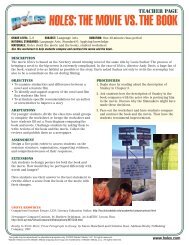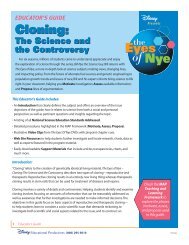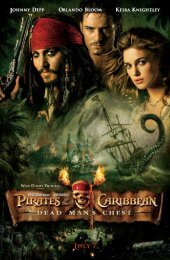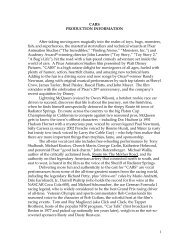Pirates of the caribbean: at world's end - Disney
Pirates of the caribbean: at world's end - Disney
Pirates of the caribbean: at world's end - Disney
You also want an ePaper? Increase the reach of your titles
YUMPU automatically turns print PDFs into web optimized ePapers that Google loves.
THE MAELSTROM<br />
After Peck, Mallory and Van Stone completed <strong>the</strong>ir “first draft,” conceptual consultant James Ward<br />
Byrkit became involved in <strong>the</strong> process, drawing illustr<strong>at</strong>ions and cre<strong>at</strong>ing o<strong>the</strong>r m<strong>at</strong>erials. “Jim came up<br />
with some wonderful stuff,” says Peck, “like how to <strong>at</strong>tack a ship, or a castle. We have all kinds <strong>of</strong> things<br />
in <strong>the</strong> book, including recipes for beer, or where you can find <strong>the</strong> best bro<strong>the</strong>l in Singapore. Jim helped<br />
us lay in <strong>the</strong> character and texture <strong>of</strong> <strong>the</strong> Pir<strong>at</strong>e Code. We have wine stains, blood stains, sunflower seeds,<br />
wax stamps and seals, and add<strong>end</strong>ums actually sewn onto <strong>the</strong> parchment pages.”<br />
The final dimensions <strong>of</strong> <strong>the</strong> Pir<strong>at</strong>a Codex were 20" x 28", with <strong>the</strong> embossed covers an inch bigger,<br />
and <strong>the</strong> “hero” version <strong>of</strong> <strong>the</strong> book weighed some 80 pounds and contained a thousand pages <strong>of</strong> textured<br />
parchment. “So we had to make two books,” Peck continues, “because we had <strong>the</strong>se two little old men in<br />
<strong>the</strong> film, sort <strong>of</strong> like a 90-year-old ZZ Top with beards down to here, playing <strong>the</strong> pir<strong>at</strong>e librarians, who<br />
have to carry it. And since Captain Teague, played by Keith Richards, is <strong>the</strong> Keeper <strong>of</strong> <strong>the</strong> Code, we<br />
wanted to give him something easier to work with. So <strong>the</strong> second version only weighed about ten pounds.”<br />
The Maelstrom<br />
For <strong>the</strong> climactic “Maelstrom” sequence <strong>of</strong> AT WORLD’S END—<strong>the</strong> massive, apocalyptic b<strong>at</strong>tle<br />
between <strong>the</strong> pir<strong>at</strong>e and British East India Trading Company armadas th<strong>at</strong> takes place in a supern<strong>at</strong>urally<br />
induced storm <strong>of</strong> monumental proportions—<strong>the</strong> filmmakers had to find a facility in which <strong>the</strong>y could<br />
build full-sized replicas <strong>of</strong> both<br />
<strong>the</strong> Black Pearl and Flying<br />
Dutchman from <strong>the</strong> decks up, as<br />
well as various o<strong>the</strong>r set pieces.<br />
The only such structure anywhere<br />
near Los Angeles (or perhaps<br />
anywhere else, for th<strong>at</strong> m<strong>at</strong>ter)<br />
was Building #703 <strong>of</strong> <strong>the</strong><br />
enigm<strong>at</strong>ically named “Site 9.”<br />
This elephantine 600-foot-long,<br />
300-foot-wide and 70-foot-tall<br />
hangar in <strong>the</strong> desert community<br />
<strong>of</strong> Palmdale, California—58 miles north <strong>of</strong> The Walt <strong>Disney</strong> Studios in Burbank—was built by Rockwell<br />
Intern<strong>at</strong>ional in 1983 for <strong>the</strong> assembly <strong>of</strong> 100 B-1 bombers, and had, over <strong>the</strong> past few years, been used<br />
as a shooting stage for a number <strong>of</strong> films, including Steven Spielberg’s “The Terminal.”<br />
“This is one <strong>of</strong> <strong>the</strong> most elabor<strong>at</strong>e and ambitious action sequences I’ve ever seen conceived for a film,”<br />
notes Rick Heinrichs, “and it requires coordin<strong>at</strong>ion <strong>of</strong> several departments, including ours, visual effects<br />
and special physical effects. If it’s even 85% <strong>of</strong> wh<strong>at</strong> we hope for, it will be <strong>of</strong>f <strong>the</strong> charts.” Adds executive<br />
producer Mike Stenson, “You walked inside <strong>of</strong> th<strong>at</strong> hangar, and it was like Area 51.”<br />
Inside <strong>of</strong> “Site 9,” Rick Heinrichs worked in synergistic conjunction with ano<strong>the</strong>r Academy Award ®<br />
winner, special effects supervisor John Frazier (“Spider-Man 2”), to construct <strong>the</strong> Pearl and <strong>the</strong><br />
Dutchman, decks up, mounted on massive, highly sophistic<strong>at</strong>ed motion bases, surrounded by gigantic<br />
blue-screen backings. “John Frazier is <strong>the</strong> best special physical effects supervisor <strong>the</strong>re is,” says Stenson.<br />
“Nobody else could have pulled <strong>of</strong>f <strong>the</strong> physical elements <strong>of</strong> <strong>the</strong> special effects th<strong>at</strong> we do in this movie.”<br />
Frazier and his team designed and built <strong>the</strong> motion bases for <strong>the</strong> two key prop ships, as well as ano<strong>the</strong>r<br />
rig for both <strong>the</strong> scene in which <strong>the</strong> Hai Peng goes <strong>of</strong>f <strong>the</strong> edge <strong>of</strong> <strong>the</strong> world, and <strong>the</strong> “Green Flash”<br />
sequence, in which <strong>the</strong> Black Pearl passes between worlds by turning completely upside down in <strong>the</strong><br />
ocean. “Wh<strong>at</strong> we decided to do on AT WORLD’S END th<strong>at</strong> has never been done before on any motion<br />
picture,” notes Frazier, “was to put a tower <strong>at</strong> each <strong>end</strong> <strong>of</strong> <strong>the</strong> two ships which allowed us to heave <strong>the</strong>m<br />
up 15 feet. And by doing th<strong>at</strong>, we were able to get <strong>the</strong> actual realistic movement <strong>of</strong> a ship in <strong>the</strong> ocean.<br />
Normally, we pivot it in <strong>the</strong> center, but ships don’t do th<strong>at</strong>. In this case, we pivoted <strong>the</strong> ships on each <strong>end</strong><br />
to bring <strong>the</strong> bow up and down, and <strong>the</strong>n we had two hydraulic rams on <strong>the</strong> ei<strong>the</strong>r side <strong>of</strong> <strong>the</strong> ships th<strong>at</strong><br />
36


